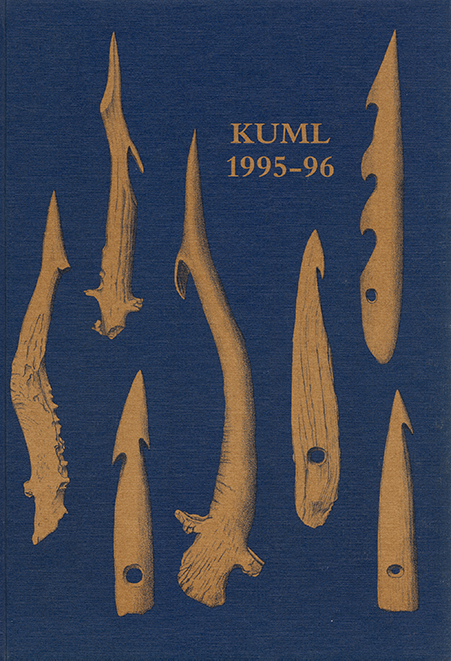Dice and Dicing in the Stone Age
DOI:
https://doi.org/10.7146/kuml.v40i40.112336Keywords:
Dice, Dicing, stone age, late stone ageAbstract
Dice and Dicing in the Stone Age
Pierced metapodials, astragali, and phalanxes were a common and widespread type of playing piece. In Egypt astragulus dice and their stone or metal imitations were known as early as the 1st dynasty or ca. 2600 B.C. Historical sources and pictures both show that gaming with astragali was popular in Classical Greece (fig. 5). I Pieter Bruegel's painting "Children's Games" from 1560 two peasant women can be seen playing with pierced astragali. Play with astragali is universal.
Astragalus dice were previously known in Denmark from the Iron Age and the Middle Ages. The Danish Neolithic finds of pierced astragali and phalanges have not earlier been considered in this context and there has earlier been much uncertainty with regard to their function.
The earliest and also the majority of the pierced metapodials and phalanxes were found at the Troldebjerg site on Langeland, where a total of 121 were recovered, 89 of them made of cattle trochleae. They date to MN Ia. The same date probably applies to a pierced trochlea from the settlement at Ryomgård on Djursland.
At Blandebjerg only three were found; at Øksnebjerg and Ørum A there was one each; but there are 21 fragments from Fannerup I. All these are datable to MN II.
In the kitchen midden at Signalbakken in Alborg there were found 13, one of them of red deer. They are datable to MN III. One astragalus dice is from Trelleborg and is the same age. At the large site at Bundsø there were found at least 30 bone dice (fig. 3). The are also datable to MN III.
At the Lindø sites, most of which are datable to MN IV, there were found 44 bone dice (fig. 4).
At the MN V settlements at As Vig and Lidsø there was found one each.
One was found on the surface at a settlement site in Viemose bog, east Zealand.
Bone dice have also been found at Middle Neolithic settlements in Sweden.
Altogether the type has been identified at at least 13 Middle Neolithic settlements and causewayed enclosures of Sarup type. There are 242 trochleae and phalanges with completed or begun hole. The number per site varies from one to 121 at Troldebjerg.
Three have been found in three different great dolmens or passage graves on the Danish islands. A perforated trochlea was found in Værebro Å river, where it may have been a ritual offering.
The finds are geographically distributed over the whole area where bones can be expected to survive (fig. 2). The type can be dated to the entire Middle Neolithic. It has not been met with on Early Neolithic settlements, so it probably first appeared in Denmark at the beginning of the MN. None are known from the younger or Late Neolithic or from the Bronze Age.
Those of domestic ox are much the commonest. Only four are made from Red Deer, while 10 are of pig bones. The bones are nearly all those of grown animals, only a small number made of calf bones.
The bones, and therefore the dimensions of the dice are very uniform. Most are ca. 5- 7 cm long, 3-5 cm wide, and 3-4.5 cm thick. The perforation has a diameter of 1-2 cm. The holes always run from one broad face through to the other, and is normally centrally placed and hourglass shaped in section. It was made by first striking in from both sides with a pointed flint tool, after which the rest of the hole was bored with a flint drill. One piece still contains a broken off fragment of the drill point.
Many have obvious marks of wear near the hole. Many have marked signs of bruising at various places, especially the raised edges at the extremities. Both examples with finished and unfinished hole show marks of bruising. The hole was therefore not essential to their use, but there is clear evidence that the objects were used.
Against the background of the many and widely scattered finds of bone dice it seems likely that the Danish Middle Neolithic pieces should indeed be interpreted as dice. They are completely alike. The bruising at the ends is the result of throwing, when the dice followed by eager eyes struck the ground. The marks of wear at the holes occurred when the dice were being carried on a cord.
The method of play with the Middle Neolithic Danish dice was probably much the same as later in other parts of Europe. Perhaps also in Denmark the auguries were taken by throwing astragalus dice.
The finds presented here are the oldest in the world. They are ca. 1000 years older than the Egyptian and ca. 3000 years older than the Greek ones. Thus astragulus playing could have been developed in Denmark, but it is more probable that its origin should be sought much further back in time.
Klaus Ebbesen
Downloads
Published
How to Cite
Issue
Section
License
Fra og med årgang 2022 er artikler udgivet i Kuml med en licens fra Creative Commons (CC BY-NC-SA 4.0).
Alle tidligere årgange af tidsskriftet er ikke udgivet med en licens fra Creative Commons.


